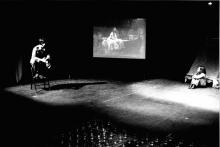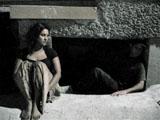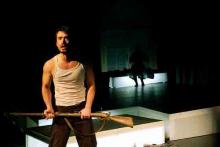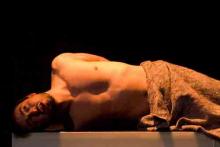Combat
Edicions
Combat. València: Tres i Quatre, 1999.
Combate i Suite. [publicades juntes]. Madrid: SGAE, 2000. (Trad. Alejandro Montiel).
Kampf. Merlin Verlag, "Merlin Theater", 2002. (Trad. Maurici Farré i Lea Niklas).
Combat. París: Éditions de l’Amandier, 2002. (Trad. Isabelle Bres).
Combat. Perfoming Arts Journal (PAJ) (Nova York), vol. XXVII, núm. 79, gener 2005, p. 65-81. (Trad. Sharon G. Feldman, Pere Bramon i Neil Charlton).
Estrenes
Estrena a la Sala Beckett de Barcelona. Gener 1998. Direcció: Ramon Simó.
Estrena en francès al Théâtre Ouvert de Luxemburg. Novembre 2001. Direcció: Nicolas Steil.
Altres muntatges en francès: a Théâtre à Corps Perdus & Le Collectif du Terrain Vague, Montréal. Maig 2005. Direcció: Geneviève L. Blais.
Estrena en alemany, al Festival Neue Akzente, Augsburg, Juny 2003. Direcció: Britta Schreiber.
Estrenada a Mèxic a Monterrey, N.L., Teatro de la Ciudad, abril 2007, companyia Balam Teatro, direcció de Monica Jasso.
Estrenada a Alemanya, Berlín, Balhaus Naunynstraße, gener 2010, direcció de Cem Sultan Ungan.
Estrena en alemany al teatre TIG7 de Manheim (Alemanya), novembre de 2012. Direcció: Stefan Grieshaber.
Lectures dramatitzades
Lectura dramatitzada al Sitges Teatre Internacional 1995.
Lectura dramatitzada al Théâtre 13 de París. Març 2002. Direcció: Philippe Macaigne.
Lectura dramatitzada al Théâtre du Rond Point de París. Octubre 2002. Direcció: Philippe Macaigne.
Lectura dramatitzada al Schille Theaterhaus de Leipzig, març 2007. Direcció: Alexander Marusch.
Resum
Català
L’acció de Combat se situa en una geografia no precisada, però de connotacions properes i universals a la vegada. És un país on conviuen dues ètnies, dues cultures, dues llengües i on ha esclatat la guerra civil. La convivència ha esdevingut combat, batalla, genocidi. La tensió dramàtica puja quan comencem a relacionar els monòlegs dels dos protagonistes i ens adonem que tots dos personatges expliquen una mateixa història. Combat presenta de forma irònica i lacerant les contradiccions que comporta la guerra, però també ens parla de la relació que s’estableix entre l’art i les persones.
Castellà
La acción de Combate se sitúa en una geografía no precisada, pero de connotaciones próximas y universales a la vez. Es un país donde conviven dos etnias, dos culturas, dos lenguas, y donde ha estallado una guerra civil. La convivencia se ha convertido en combate, batalla, genocidio. La tensión sube cuando empezamos a relacionar los monólogos de los dos protagonistas y nos damos cuenta que los dos están contando la misma historia. Combate presenta, de forma irónica y lacerante, las contradicciones que conlleva la guerra, pero también nos habla de la relación que se establece entre el arte y las personas.
Alemany
Ein Bürgerkrieg irgendwo in Europa. Eine Frau verliert ihren Mann, ihre Wohnung, alles. Sie lebt nun in einem notdürftig eingerichteten Dachzimmer. Ein junger Soldat, der die Frau in einer Bar kennen lernt, geht zu ihr, bevor er an die Front muss. Nach ihm werden andere Soldaten die Treppen zu ihr hinaufsteigen, regelmäßig. Für die Frau ist es eine Art Befreiung. Als die Belagerung vorbei ist, die Siegertruppen durch die Straßen ziehen, kommt der junge Soldat zu ihr zurück. Doch für die Frau hört hier die Geschichte auf, der Punkt ist erreicht, an dem ihr Leben sinnlos geworden ist.
Anglès
Combat has an eight-scene structure, presented as a series of alternating monologues between a woman, known simply as Ella (“She”), and a man, known merely as Ell (“He”). Ell is a young (twenty-year-old) soldier, who has recently enlisted to serve in the war. He spends with her his last night as a civilian, before going off to combat. It is his first sexual liaison and they fall in love. Gradually it becomes evident to the spectator that, in the enigmatic poetry of their monologues, both Ell and Ella are alluding to a shared traumatic event that occurred three months after their first amorous encounter and just a moment prior to the initiation of the monologues themselves. Batlle thus presents the audience with pieces of a puzzle that create an intricately designed structure, in which insinuating elements of an anecdote gradually coalesce only to reveal the full picture by the time the play comes to an end. Death, paradoxically, becomes both the point of departure and the point at which the monologues terminate, thereby creating a circular configuration of infinite repetition.
The plot of Combat is interlaced with a series of ekphrastic evocations of John William Waterhouse’s pre-Raphaelite painting The Lady of Shallot (1888) and Alfred Lord Tennyson’s eponymous poem (1832). Both artistic works, based on a female figure of Arthurian legend, serve as points of inspiration for the fictionalization of reality and the portrayal of a so-called “landscape in the aftermath.” In a literal sense, the “aftermath” here refers to a war that is taking place and to the lives of a man and a woman that are extinguished as a result. Batlle’s play uses the painting and poem as intertextual templates in creating a portrait of a war-ravaged landscape from the perspective of death and anguish. In contemplating the space of this landscape, the spectator is invited to ponder the fluid nature of boundaries, identities, and hybridities: those that are spatial, physical, or corporal and those that are aesthetic, ethnic, racial, cultural, or linguistic.





